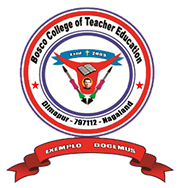
Bosco College of Teacher Education, Dimapur
Menu
Bosco College of Teacher Education, Dimapur

E.P. 1.1. Number of students on roll year-wise during the last five years
E.P. 1.2. Number of seats sanctioned year wise during the last five years
E.P. 1.3 . Number of seats earmarked for reserved category as per GOI/ State Govt. rule year wise during the last five years
E.P. 1.4 . Number of outgoing/ final year students who appeared for final examination year wise during the last five years.
E.P. 1.5 . Number of graduating students year-wise during last five years.
E.P. 1.6 . Number of students enrolled(admitted) year-wise during the last five years.
E.P. 2.1 . Number of full time teachers year wise during the last five years.
E.P. 2.2 . Number of Sanctioned posts year wise during the last five years.
E.P. 3.1 . Total expenditure excluding salary year wise during the last five years (INR in lakhs).
E.P. 3.2 . Number of Computers in the institution for academic purposes.
1.1 Curriculum Design and Development
1.2 Academic Flexibility
1.3 Curriculum Enrichment
1.4 Feedback System
2.1 Student Enrollment and Profile
2.2 Honoring Student Diversity
2.3 Teaching- Learning Process
2.4 Competency and Skill Development
2.5 Teacher Profile and Quality
2.6 Evaluation Process
2.7 Student Performance and Learning Outcomes
2.8 Students’ Satisfaction Survey
3.1 Resource Mobilisation for Research
3.2 Research Publications
3.3 Outreach Activities
3.4 Collaboration and Linkages
4.1 Physical Facilities
4.2 Library as a learning Resource
5.1 Student Support
5.2 Student Progression
5.3 Student Participation in Activities
5.4 Alumni Engagement
6.1 Institutional Vision and Leadership
6.2 Strategy Development and Deployment
6.3 Faculty Empowerment Strategies
6.4 Financial Management and Resource Mobilization
6.5 Internal Quality Assurance System
7.1 Institutional Values and Social Responsibilities
7.2 Best Practices